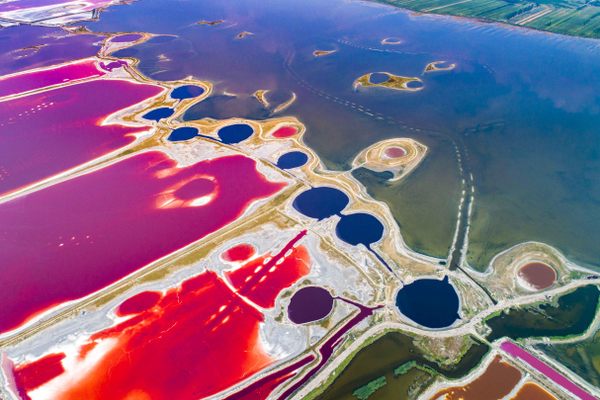The Earth’s Wildest Reactions to High Tides
You can thank the moon’s gravitational pull for these nine extraordinary sights.

The highest of high tides, called a spring tide, occurs when the earth, moon, and sun all line up, which they do at each Full Moon and New Moon. This alignment also happens, of course, during a solar eclipse, and the resulting spring tide is one of the more overshadowed aspects of North America’s upcoming astronomical rarity.
In general though, spring tides bring about some wonderfully strange natural phenomena, especially in places with the most drastic fluctuations in sea level, including parts of Canada and the United Kingdom. Here are nine wild, watery places to appreciate the extraordinary effects of the moon’s tidal force.

Saltstraumen Maelstrom
Bodo, Norway
In a narrow channel in Norway’s Saltstraumen sound is the strongest tidal current in the world. As the tide tries to fill Skjerstad fjord, up to 440 million tons of seawater forces its way through a narrow strait, with water speeds reaching 23 miles per hour. The powerful movement causes a series of whirlpools to form, called maelstroms due to their extraordinary force. When the current is at its strongest, the swirling vortices can reach up to 16 feet deep at the eye of the vortex. The Saltstraumen maelstrom is believed to be the most powerful tidal whirlpool on the planet.

Reversing Falls
Saint John, Canada
The Bay of Fundy is home to the largest tidal range in the world, with variations between high tide and low tide reaching upwards of 52 feet, roughly the same height as a five-story building. Due to these drastic surges, when the powerful tides come up—some of the highest in the world—it can cause the river waters to reverse course multiple times throughout the day. Remarkably, at the bay’s “Reversing Falls,” a series of powerful (if squat) waterfalls also change direction with the tidal current.

Severn Bore
Minsterworth, England
Britain’s Severn river also has an exceptionally large tidal range—the water level difference between low and high tide—which causes one of the world’s most spectacular tidal bores, a large wave that flows upstream against the current. On the days when the bore is strongest—like it was during the “super tide” that coincided with the 2015 solar eclipse—surfers and tourists flock from around England to experience the curious wave. In fact, the River Severn is the birthplace of river surfing, a sport that wouldn’t exist without tidal bores.

Hopewell Rocks: ‘Flower Pots’
Hopewell Cape, Canada
Also known as the “Flowerpot Rocks” due to their unique tapered shape, the Hopewell Rocks are one of the most unique tidal formations in North America. Caused by the ever-moving tide off the Canadian coast, these rocks have spindly bases and arches that continue to be gnawed away at by the sea. The tidal level here is drastic enough that one can walk the beach at the base of the stones one day and be 50 feet underwater the next on the very same spot.

The Silver Dragon: Qiantang Tidal Bore
Jiaxing, China
The rising tide coming in from Hangzhou Bay is funneled by the shape of the Qiantang River into the world’s largest tidal bore, a long breaking wave known as the “Silver Dragon,” which sometimes reaches 30 feet high. The tidal bore is first seen as a distant stroke of silver on the horizon, then the rushing sound of a great waterfall can be heard growing steadily louder as it approaches at a speed up to 25 miles per hour. Visitors have flocked to view the phenomenon for hundreds of years during the highest tides. Indeed, the regular occurrence of the Silver Dragon produced the oldest known tide table in 1056, to help tourists arrive in time to see the fast-moving wave.

Salin Aigues-Mortes
Aigues-Mortes, France
Salt marshes can be found around the world, and are an especially stunning result of the ocean’s ebb and flow. They form along coasts where the tides have flooded part of the land, and the ecosystem has evolved to flourish in the saltwater. Pink salt marshes are more common than you would think, but one that actually has pink flamingos stalking its waters, like you’ll find at Salin Aigues-Mortes in Southern France, is truly something special.

Salt Ponds of San Francisco Bay
Newark, California
Of all the tidal wetlands around the globe, few can compare to the kaleidoscope of color that brightens the grey landscape of the San Francisco Bay. These configurations of color against the drab shades of the bay are the San Francisco Bay salt ponds. The bright pond pockets of red and green are caused by the organisms or micro-algae living within them. The colors are reactions to salt levels, creating a stunning canvas of vibrant hues.

Old Sow Whirlpool
Eastport, Maine
The largest tidal whirlpool in the Western Hemisphere can be found off the coast of downeast Maine. Called the Old Sow whirlpool, it has been strange site for hundreds of years, caused by the enormous tides and the particular terrain of the ocean floor in the area. While it is one of the largest in the world, with a diameter of around 250 feet, the speed of its vortex does not come close to being the fastest.

Mokolea Lava Pools
Kilauea, Hawaii
This partially submerged lava-ledge sits 20 feet above the sea, but the incoming tidal waves are often twice that height, drowning the rocks before receding to reveal a series of tidal pools in ancient lava formations. The largest and most photogenic of these pools is roughly the size of a hot tub and fills with thrashing sea water before receding back with the tide. Sea life is often caught in the strong tides, getting shoved up through the pools and briefly trapped in the pools.































Follow us on Twitter to get the latest on the world's hidden wonders.
Like us on Facebook to get the latest on the world's hidden wonders.
Follow us on Twitter Like us on Facebook